November 2024
The global virtual production market size is calculated at USD 3.21 billion in 2025 and is forecasted to reach around USD 11.02 billion by 2034, accelerating at a CAGR of 14.72% from 2025 to 2034. The North America virtual production market size surpassed USD 1.00 billion in 2024 and is expanding at a CAGR of 14.78% during the forecast period. The market sizing and forecasts are revenue-based (USD Million/Billion), with 2024 as the base year.
The global virtual production market size was estimated at USD 2.79 billion in 2024 and is predicted to increase from USD 3.21 billion in 2025 to approximately USD 11.02 billion by 2034, expanding at a CAGR of 14.72% from 2025 to 2034. The increasing penetration of technology and the internet in the media and entertainment industry is driving the growth of the market.
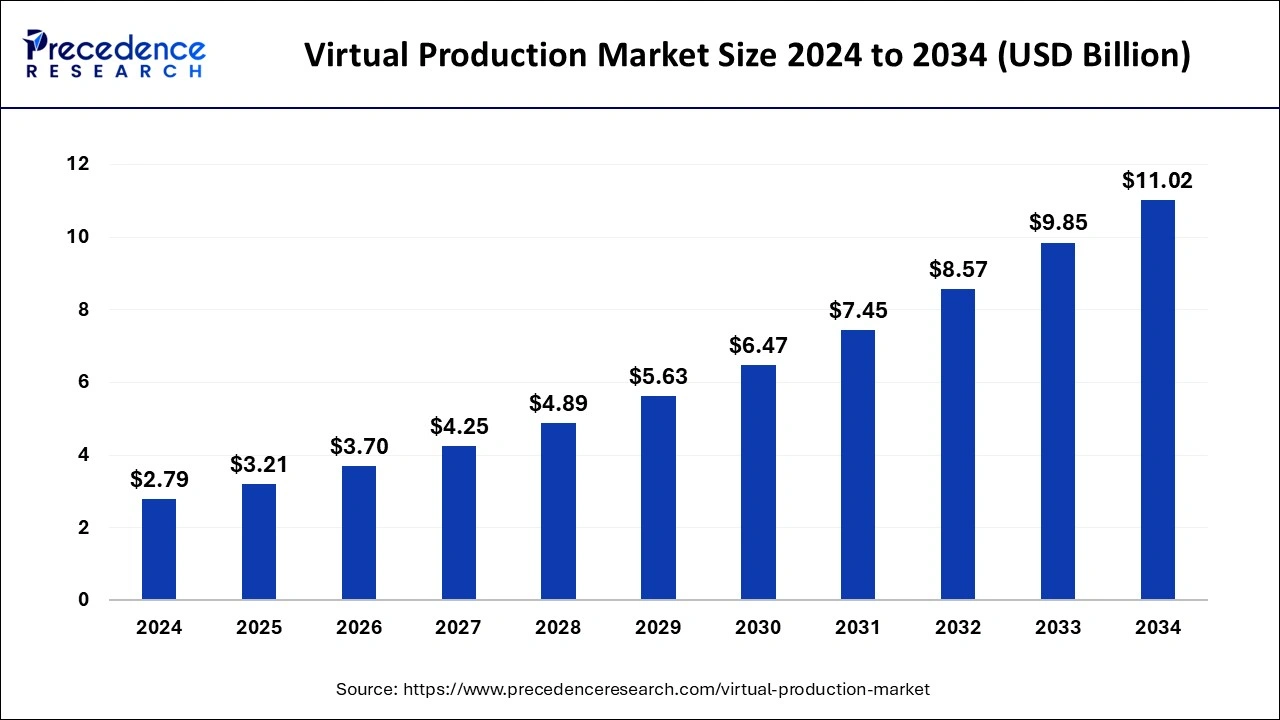
The U.S. virtual production market size was estimated at USD 750 million in 2024 and is predicted to be worth around USD 3,050 million by 2034, at a CAGR of 15.06% from 2025 to 2034.
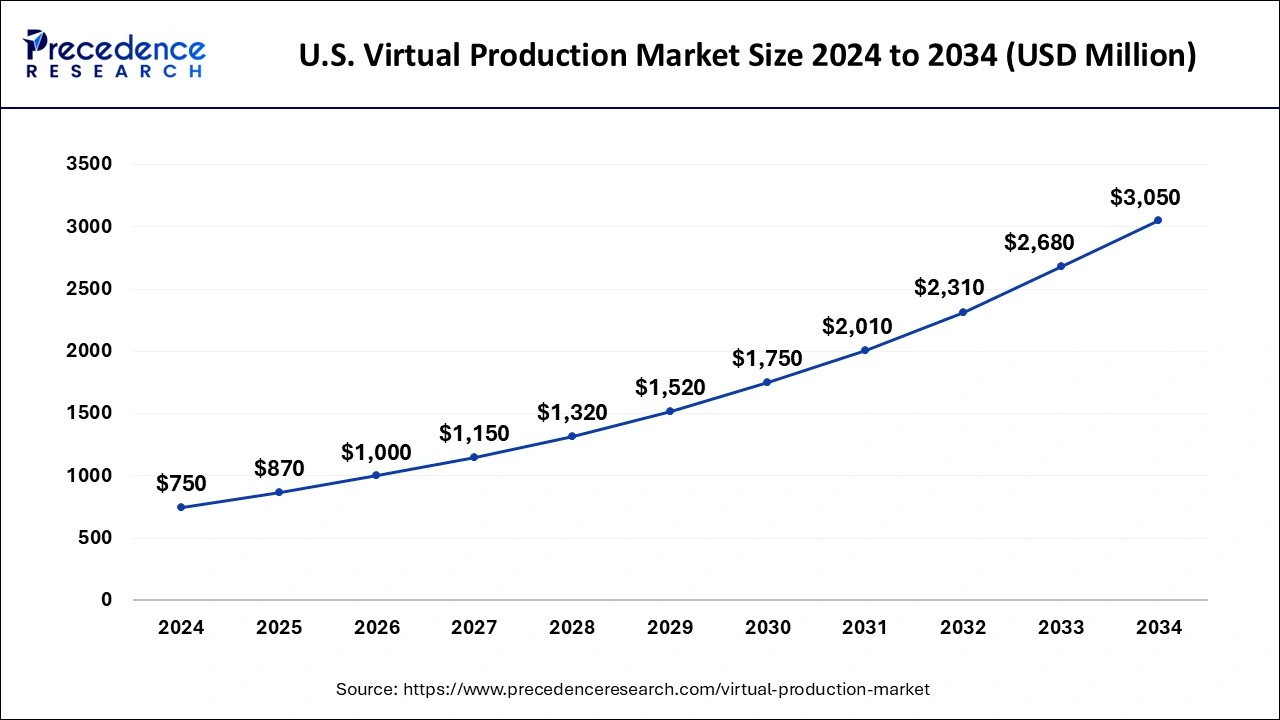
North America led the virtual production market, which had the largest size in 2024. The growth of the market in the region is increasing due to the rising number of large-scale production houses in the media and entertainment industry that drive the market's growth. The early adoption of the technologies in every sector due to the higher economic stability in countries like the United States, the higher audience ratio that are interested in science fiction movies, and the increasing number of OTT platforms in the region which is driving the demand for the visual effects in their shows and movies are contributing in the growth of the market. The rising investments by the major market players in the evaluation of virtual technologies are the factors driving the growth of the market in the region. The Media and entertainment industry is one of the most important sides of the U.S. economy due to the presence of Hollywood, which plays a crucial part as the center of the entertainment media.
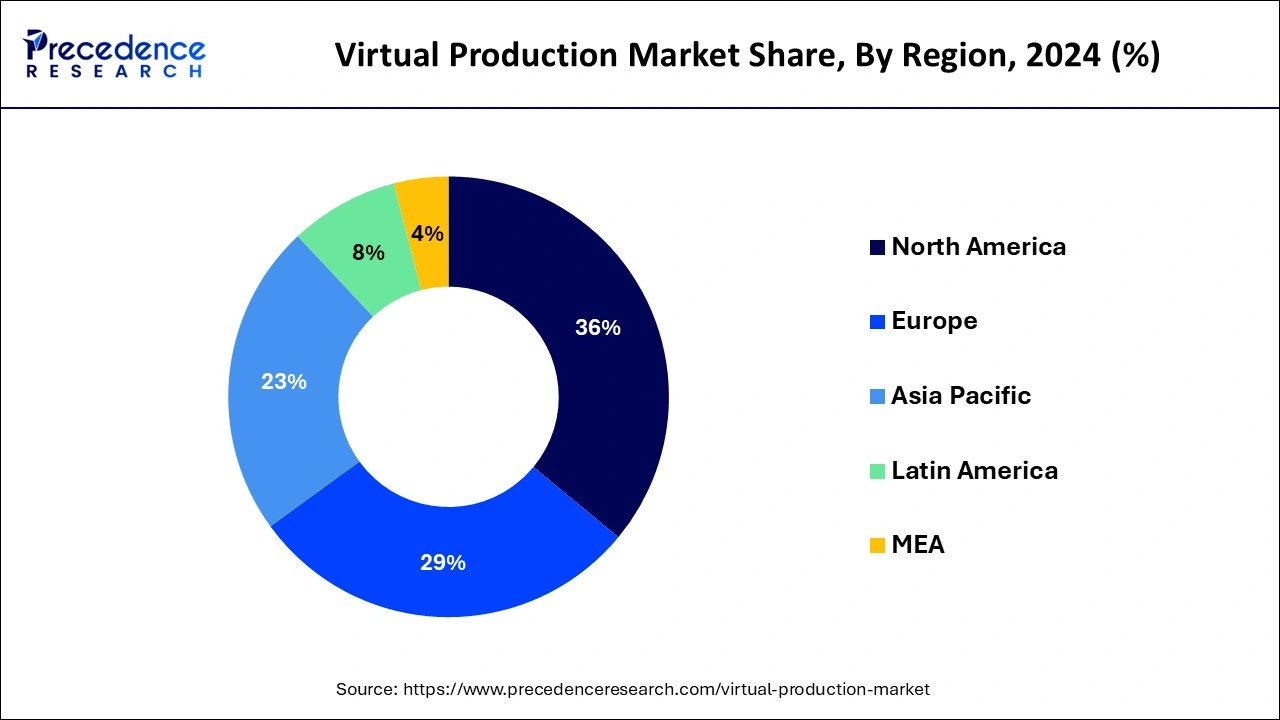
Asia Pacific is expected to witness the fastest growth during the forecast period. The growth of the market in the region is expected to increase due to the rising technological adoption in the media and entertainment industry due to its cost and time-saving properties. The increasing audience of the technologies and science fiction characters and movies in the younger generation drives the demand for the market. Additionally, the rising population, especially the younger generation, is more aware of the visual effects in the media and gaming industry, which is also a factor that accelerates the growth of the virtual production market in the region.
Virtual production is the integration of virtual and physical filmmaking technologies to make revolutionary media. Virtual production uses real-time 3D engines to create realistic sets in real-time and displays them in the large LED walls in the physical sets. The media and entertainment industry is one of the major industries that use virtual production systems. Virtual production is nothing but connecting more virtually. Virtual production allows studios to build bigger, deliver high-quality results, and be more innovative in the earlier production process. It minimizes the cost of making a real set on the sites, which saves time and money; it reduces the time and money spent traveling in the real location and additional expenses. The rising media entertainment and gaming industry worldwide is driving the growth of the virtual production market.
| Report Coverage | Details |
| Growth Rate from 2025 to 2034 | CAGR of 14.72% |
| Market Size in 2025 | USD 3.21 Billion |
| Market Size by 2034 | USD 11.02 Billion |
| Largest Market | North America |
| Base Year | 2024 |
| Forecast Period | 2025 to 2034 |
| Segments Covered | By Component, By Type, and By End-User |
| Regions Covered | North America, Europe, Asia-Pacific, Latin America, and Middle East & Africa |
Rising use in the filmmaking industry
Virtual production had a huge impact on the filmmaking industry. In recent times, virtual production has become more popular in the large-scale production of filmmaking. Virtual production allows filmmakers greater flexibility in terms of location. Virtual production can create the set or the effects of mountains, rivers, or any other site in real-time without going to a specific location, as well as reduce the requirement of the physical sets, decreasing the cost and time of shooting as compared to traditional shooting. Virtual production provides more control over lightning, and using the LED wall offers a blend of digital and traditional lightning, which increases the control over the look and feel of the scenes. Virtual production can also help the actors to perform more efficiently in a virtual environment with highly realistic visuals and motion capture data. Virtual production can help filmmakers revolutionize content. Thus, the higher adoption of virtual production by filmmakers drives the growth of the virtual production market.
Lack of knowledge
Virtual production is a rapidly growing market that holds great potential for the entertainment industry. However, despite its promise, there are still barriers to entry that prevent smaller production houses from adopting this technology. One of the biggest challenges is the need for skilled professionals to manage the virtual production process. This requires a larger investment in training and hiring, which may not be feasible for smaller companies. Additionally, the high-end technological equipment and software required for virtual production can be costly, making it even more challenging for small and medium-sized businesses to invest in. These factors limit the adoption of virtual production by smaller companies, which in turn restricts the growth of the virtual production market. Addressing these challenges will be crucial to unlocking the full potential of this exciting technology.
Increasing implementation of the VFX
VFX is emerging with virtual production. VFX is highly adopted by large-scale filmmaking production houses, animation movies, high-end dramas, and video games that drive the demand for VFX. VFX stands for visual effects, which is mostly used in science fiction or big-budget action movies. Three major types of the VFX process are compositing, CGI, and motion capture. There are some of the majorly used VFX software that are commonly like Adobe After Effects, Maxon Cinema 4D, Autodesk Maya, Syntheyes, 3Ds Max, Houdini, Boujou, Mocha, Nuke, etc.
VFX artists use such types of tools to blend the line between the real and the unreal. VFX helps to maintain the quality, and the end goal is to make something fake look real. The rising audience of sci-fi and action movies is driving the demand for the VFX into the movies, which has contributed to the emergence of the virtual production market in the forecast period.
The software segment dominated the market with the highest share in 2024. The growth of the segment is attributed to the increasing adoption of virtual production software by the filmmaking industry, which is driving the demand for the segment. The virtual production software used in the game engines makes the film sets in real time. Virtual production software offers a wide range of applications under the overarching workflow. Rendering, modeling, compositing, and tracking are some of the important tasks in the virtual production process. There are some of the highly used virtual production software such as Unreal Engine-best overall, SceneForge Studio- suitable for beginners, Unity- the best community-based platform, Maya- most versatile, Houdini- node-based production, MotionBuilder- for motion tracking, Bonus- real-time collaboration tool.
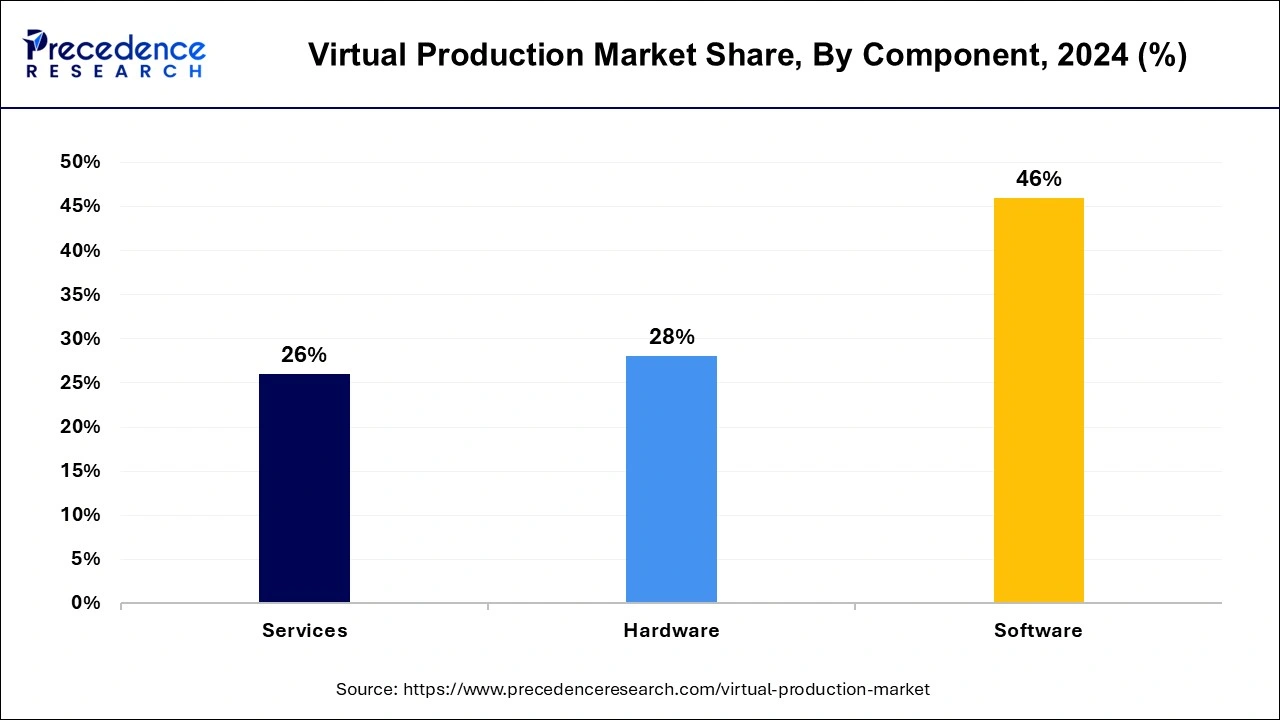
The rising association of artificial intelligence and machine learning in virtual production drives the growth of the virtual production market. Additionally, continuous technological evolution in the virtual production software, such as advancements in the VFX feature, are also contributing to the expansion of the market.
The production segment is projected to grow at the fastest rate during the forecast period. The growth of the segment is attributed to the increasing implementation of virtual effects at the time of production, which drives the demand for virtual production. Virtual effects like VFX play an important role in the production process of editing videos and graphics.
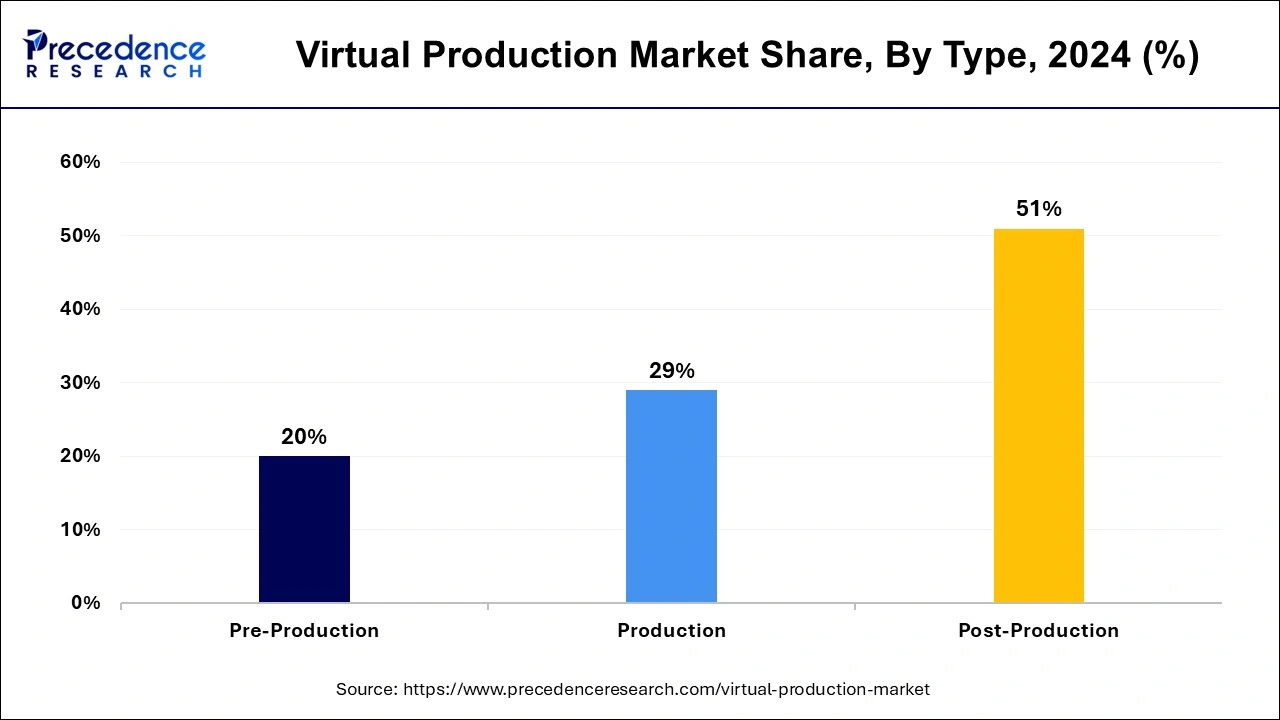
The increasing audience of science fiction movies, large-scale action movies, and the gaming industry drives the growth of virtual effects in the production area. The integration of motion captures the imaginary characters and high-quality visual graphics in the 3D dimensional environment has gained popularity. The increasing competition in the media and entertainment industry and the rising interest in quality and high-end pictures are driving the expansion of the market.
The TV series segment dominated the virtual production market in 2023. The growth of the segment is attributed to the rising share of TV series and OTT series in the media and entertainment industry, and the rising interest in Sci-fi OTT series and TV shows is driving the demand for virtual production or visual effects. The rising penetration of internet-based TV shows and series across the world is boosting the demand for the market. Additionally, the technological evaluation of TVs, like the integration of smart technologies in television sets and the integration of the Internet, is gaining popularity. The rising number of OTT platforms and the rising investments in Internet-based series are driving the demand for visual effects in TV series and the growth of the market.
By Component
By Type
By End-User
By Geography
For inquiries regarding discounts, bulk purchases, or customization requests, please contact us at sales@precedenceresearch.com
No cookie-cutter, only authentic analysis – take the 1st step to become a Precedence Research client
November 2024
November 2024
January 2025
November 2024